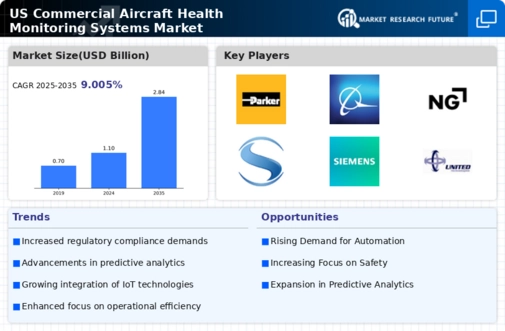The commercial aircraft-health-monitoring-systems market is characterized by a dynamic competitive landscape, driven by technological advancements and increasing demand for operational efficiency. Key players such as Honeywell International Inc. (US), General Electric Company (US), and Boeing Company (US) are at the forefront, each adopting distinct strategies to enhance their market positioning. Honeywell International Inc. (US) focuses on innovation in predictive maintenance technologies, while General Electric Company (US) emphasizes digital transformation through its digital twin technology, which enhances aircraft performance monitoring. Boeing Company (US) is leveraging partnerships with tech firms to integrate AI into its health-monitoring systems, thereby improving data analytics capabilities. Collectively, these strategies contribute to a competitive environment that prioritizes technological innovation and operational excellence.
In terms of business tactics, companies are increasingly localizing manufacturing and optimizing supply chains to enhance responsiveness and reduce costs. The market structure appears moderately fragmented, with several key players exerting influence over various segments. This fragmentation allows for niche players to emerge, yet the collective strength of major companies like Thales Group (FR) and L3Harris Technologies, Inc. (US) ensures that competition remains robust and innovation-driven.
In October 2025, Honeywell International Inc. (US) announced a strategic partnership with a leading aerospace software company to develop advanced health-monitoring solutions that utilize machine learning algorithms. This collaboration is poised to enhance predictive maintenance capabilities, potentially reducing aircraft downtime and operational costs for airlines. The strategic importance of this partnership lies in its ability to leverage cutting-edge technology to provide airlines with actionable insights, thereby improving overall fleet management.
In September 2025, General Electric Company (US) unveiled a new suite of health-monitoring tools designed to integrate seamlessly with existing aircraft systems. This initiative reflects a commitment to enhancing the user experience for operators and maintenance crews. By streamlining data collection and analysis, GE's new tools could significantly improve maintenance scheduling and reduce operational disruptions. The strategic relevance of this development is underscored by the growing need for efficient maintenance solutions in an increasingly competitive market.
In August 2025, Boeing Company (US) launched a new AI-driven analytics platform aimed at optimizing aircraft health monitoring. This platform is designed to provide real-time insights into aircraft performance, enabling operators to make informed decisions regarding maintenance and operational efficiency. The strategic significance of this initiative lies in its potential to transform how airlines approach maintenance, shifting from reactive to proactive strategies that enhance safety and reduce costs.
As of November 2025, current trends in the commercial aircraft-health-monitoring-systems market are heavily influenced by digitalization, sustainability, and AI integration. Strategic alliances are increasingly shaping the competitive landscape, as companies recognize the value of collaboration in driving innovation. Looking ahead, competitive differentiation is likely to evolve, with a pronounced shift from price-based competition to a focus on technological innovation, reliability, and supply chain efficiency. This transition suggests that companies that prioritize R&D and strategic partnerships will be better positioned to thrive in an increasingly complex market.






















Leave a Comment